
Essential Workers
During the ongoing Pandemic, the NMAI would like to send a special thanks to all the essential workers across the United States and around the world that are dedicated to helping in this time of crisis.
While these times are unprecedented, the Golden Age Illustrators have portrayed many of these critical professions in magazine covers and advertisements. The professions of doctors, firemen, police officers, postal workers, and many more have played critical roles in society throughout the 20th century and continue to prove themselves invaluable today.
We are beyond grateful for the continuous hard work and courage each essential worker puts forward every day to keep all safe.
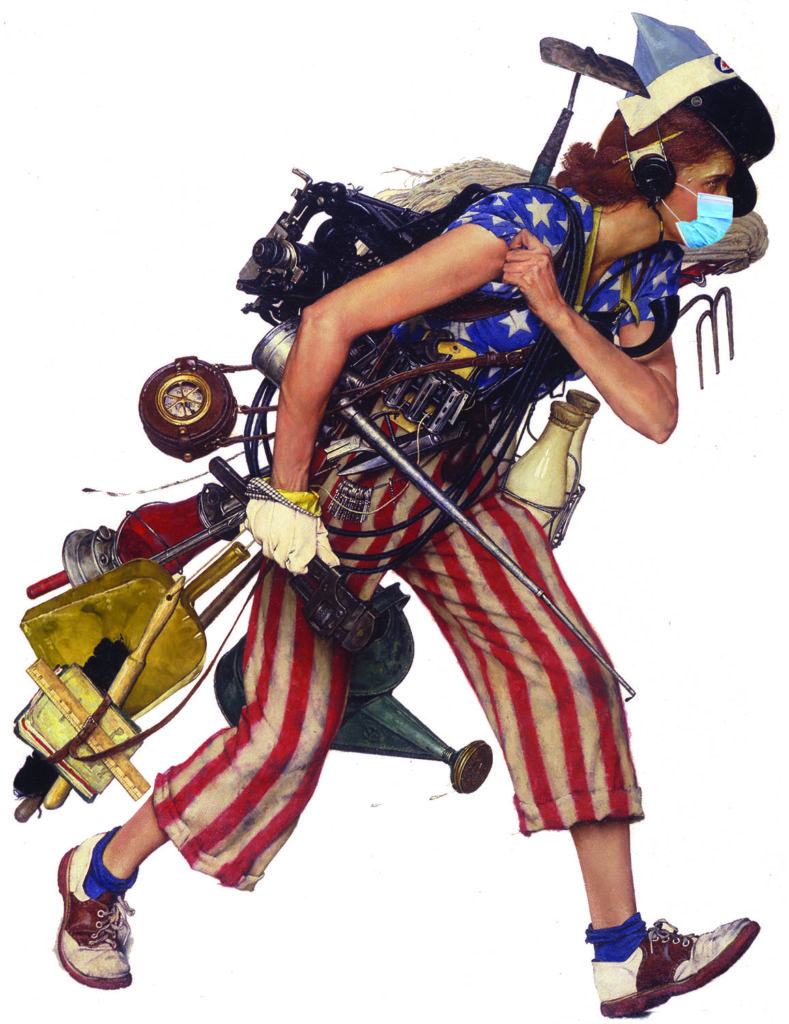
Norman Rockwell's "Miss Liberty,"
wearing the tools of all Essential Workers,
doing her part by wearing a mask!
William Medcalf (1920-2005)
Country Doctor
Oil on masonite
32 1/2" x 30", signed lower right
Brown & Bigelow calendar illustration, c. 1950's
Capturing the old-fashioned practice of Doctor’s making house calls, William Medcalf created this charming scene for a Brown & Bigelow calendar illustration. The Doctor has come to see a sick child, bundled in a quilted blanket by the wood burning stove with his loyal pet at his side. After an examination, the Doctor now administers a spoonful of medication from his black doctor’s bag open on the floor. The anticipation of the medicine is enough to cause a knee-jerk reaction in the child, holding his nose to help combat the bad taste.

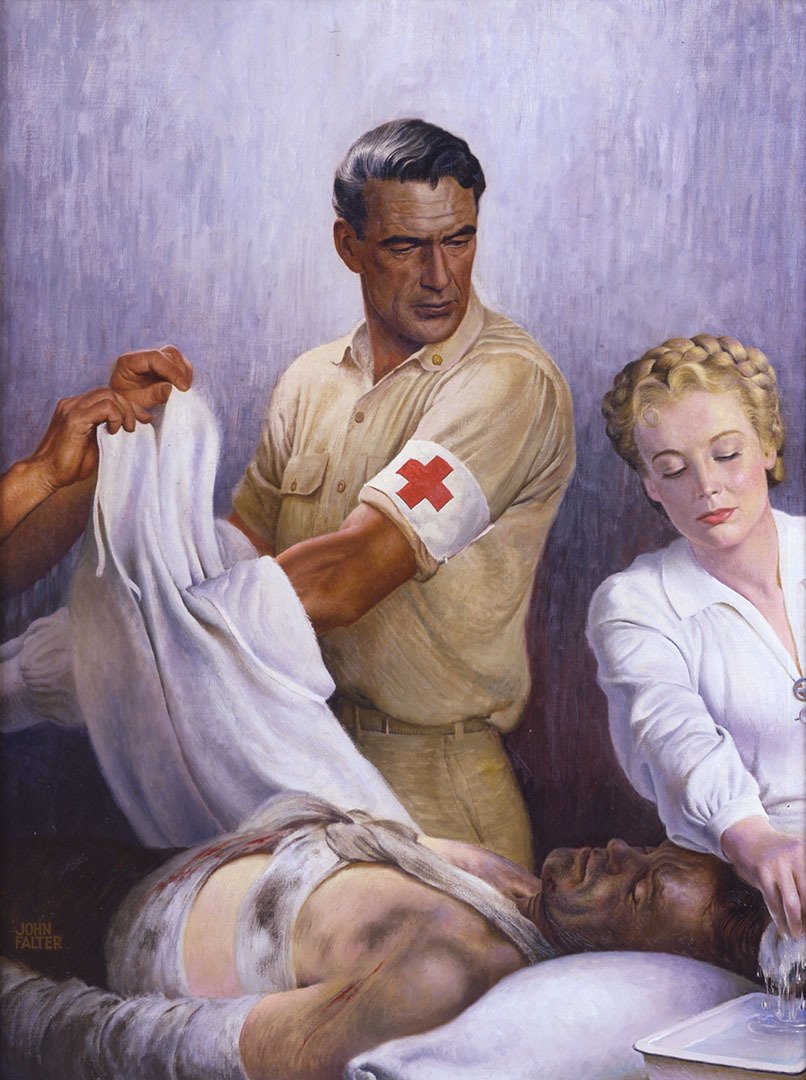
John Falter (1910-1982)
The Story of Dr. Wassell
1944, oil on canvas
35 1/2" x 26 1/2", signed lower left
Advertisement for "The Story of Dr. Wassell," a Cecil B. DeMille movie starring Gary Cooper
Based on the book of the same name by James Hilton, Cecil B. DeMille brought “The Story of Dr. Wassell” to life in this 1944 World War II movie centered in the Dutch East Indies. The story was followed the actions of U.S. Navy Dr. Corydon M. Wassell during World War II, which were chronicled in a radio broadcast by President Roosevelt in April 1942. For the movie’s print advertisement, John Falter painted Gary Cooper as a brave, stoic doctor tending to an injured soldier, with actress Lorraine Day as the nurse assisting him. The bright, circular lighting around Cooper is reminiscent of a halo, emphasizing the sacred importance of field doctors during wartime.
Stevan Dohanos (1907-1994)
The Stamp Collector
c. 1940, oil on canvas
22” x 20 1/2”, signed lower right
Medical Times cover, c. 1940's
A frequent contributor to the Medical Times, Dohanos created this lighthearted cover depicting a young boy hospitalized with a broken leg showing off his stamp collection to his Doctor and Nurse. Using his time in bed wisely, the boy meticulously sorts his reserved box of old stamps and envelopes, trimming them down and carefully saving them in his prized book.
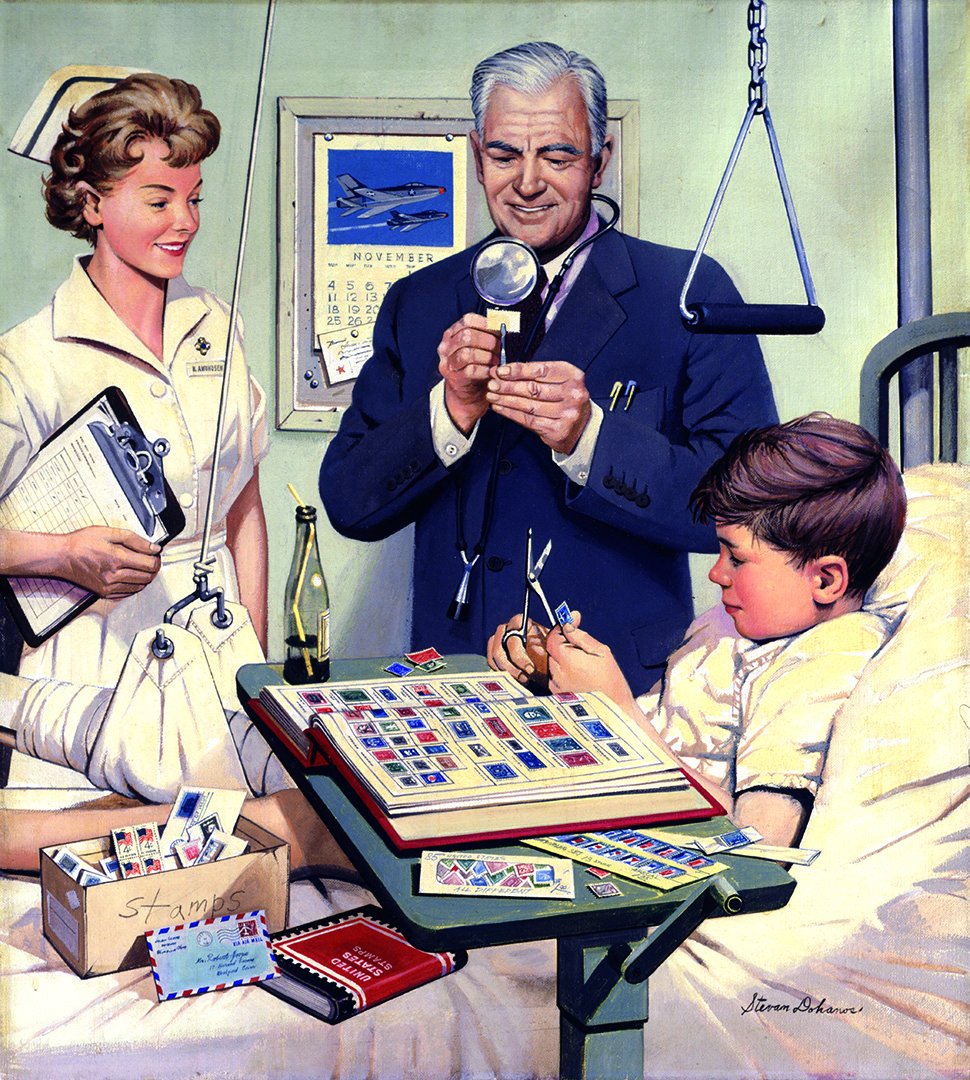
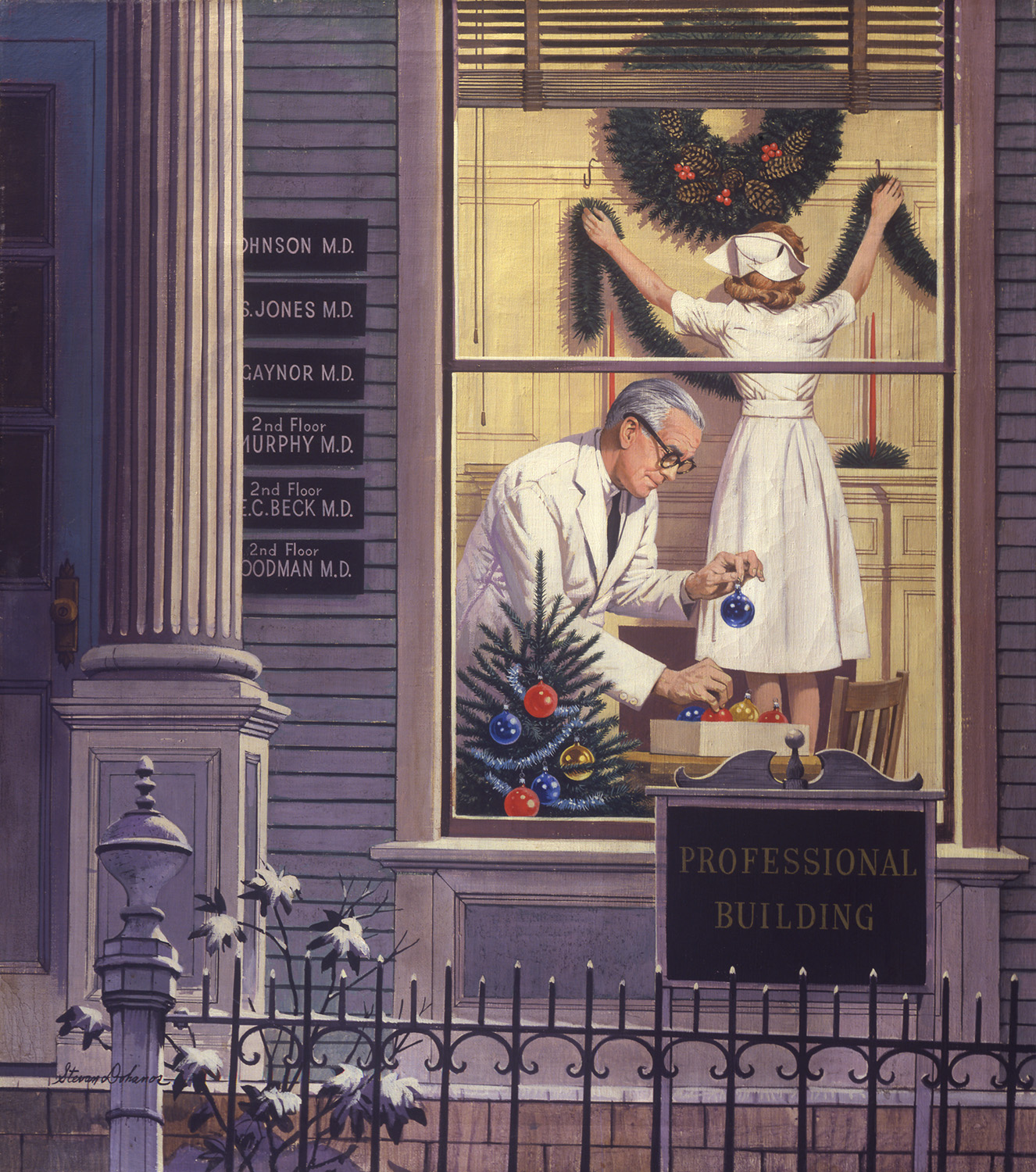
Stevan Dohanos (1907-1994)
Christmas Decorating
1960, oil on canvas
34” x 30”, signed lower left
Medical Times cover, c. 1960's
Another illustration for the Medical Times, this Christmas cover depicts a non-medical moment in a doctor’s office. The doctor carefully extracts glass ornaments from their storage box with the care of a surgeon, while the nurse expertly hangs garland above the fireplace, imbuing the space with the holiday spirit to welcome all of their patients.
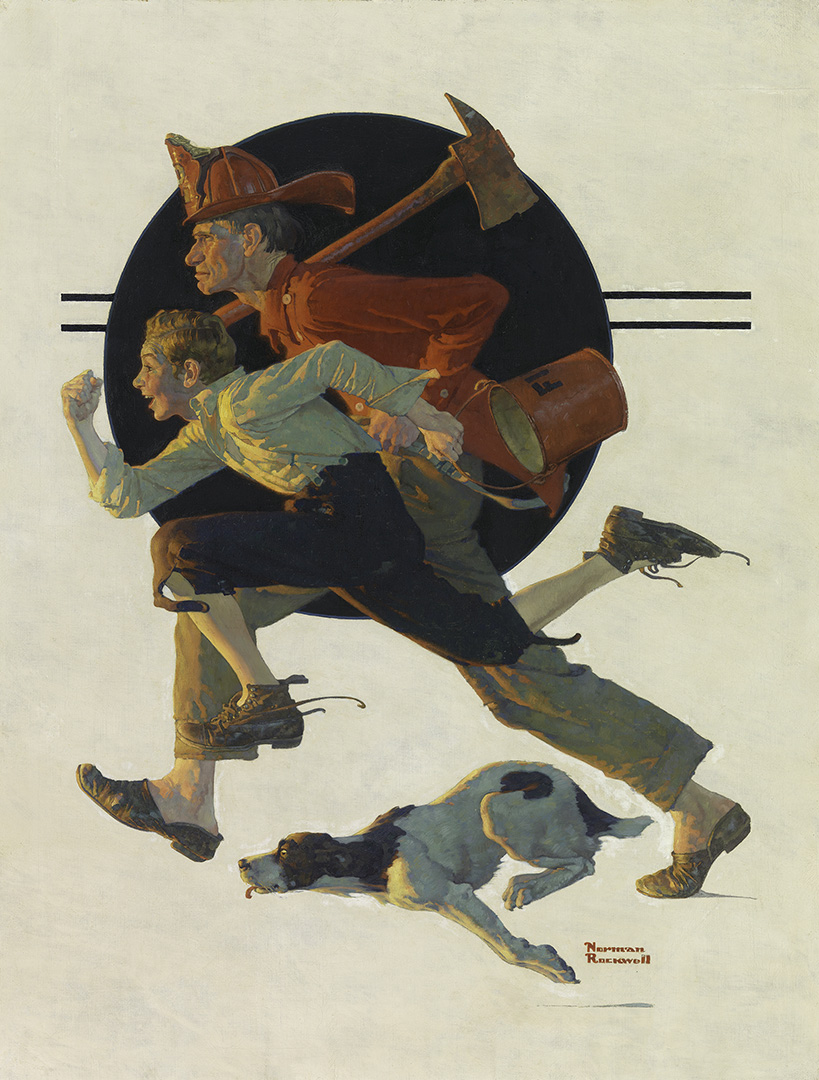
Norman Rockwell (1894-1978)
Volunteer Fireman
1931, oil on canvas
41" x 31”, signed lower right
Saturday Evening Post, March 28, 1931 cover
For this 1931 cover of the Saturday Evening Post, Rockwell portrays an eager young boy volunteering to tag along with a veteran firefighter. The boy’s adrenaline is driving him rapidly towards the pure excitement of the fire while the experienced firefighter assesses the situation with seriousness, anticipating the possible dangers that lies ahead. This stark contrast between the two character’s expectations show how perspectives change with maturity and experience. Rockwell depicts the urgency of the situation in the fireman's slippers and the boy's untied shows and unbuttoned pants, implying a hasty dressing and no time for alternatives. The glow of the nearing fire is reflected in the warm hues of their faces and clothes, and the family dog "along for the ride"!
John Falter (1910-1982)
Chasing the Fire Engine
1956, oil on canvas
29” x 23 1/4”, signed lower left
Saturday Evening Post, June 30, 1956 cover
With similar sentiments as Rockwell’s Volunteer Fireman, John Falter created this 1956 Saturday Evening Post cover juxtaposing the reactions of different generations to a fire. The experienced firemen drive ahead toward the burning barn in the distance, eager to arrive to assess the damage and take the appropriate steps to remedy the situation. At the same time three young boys chase behind on bicycles and a horse with a dog tagging along, simply to watch the action unfold.


Stevan Dohanos (1907-1994)
Firehouse - Dalmatian with Pups
1945, tempera on board
30” x 24”, signed lower right
Saturday Evening Post, January 13, 1945 cover
Approaching the theme of firemen from a different perspective, Stevan Dohanos illustrated the chaotic moment of the firetruck departing the firehouse from the dog’s perspective. Using the traditional Dalmatian in the role of the firehouse dog, she stands alert over her litter of newly born puppies who have awoken from the commotion. This unique composition reminds the viewer of the dedication firemen bring to their work, ready at a moment’s notice, and of the families they leave behind when they respond to a call for help.
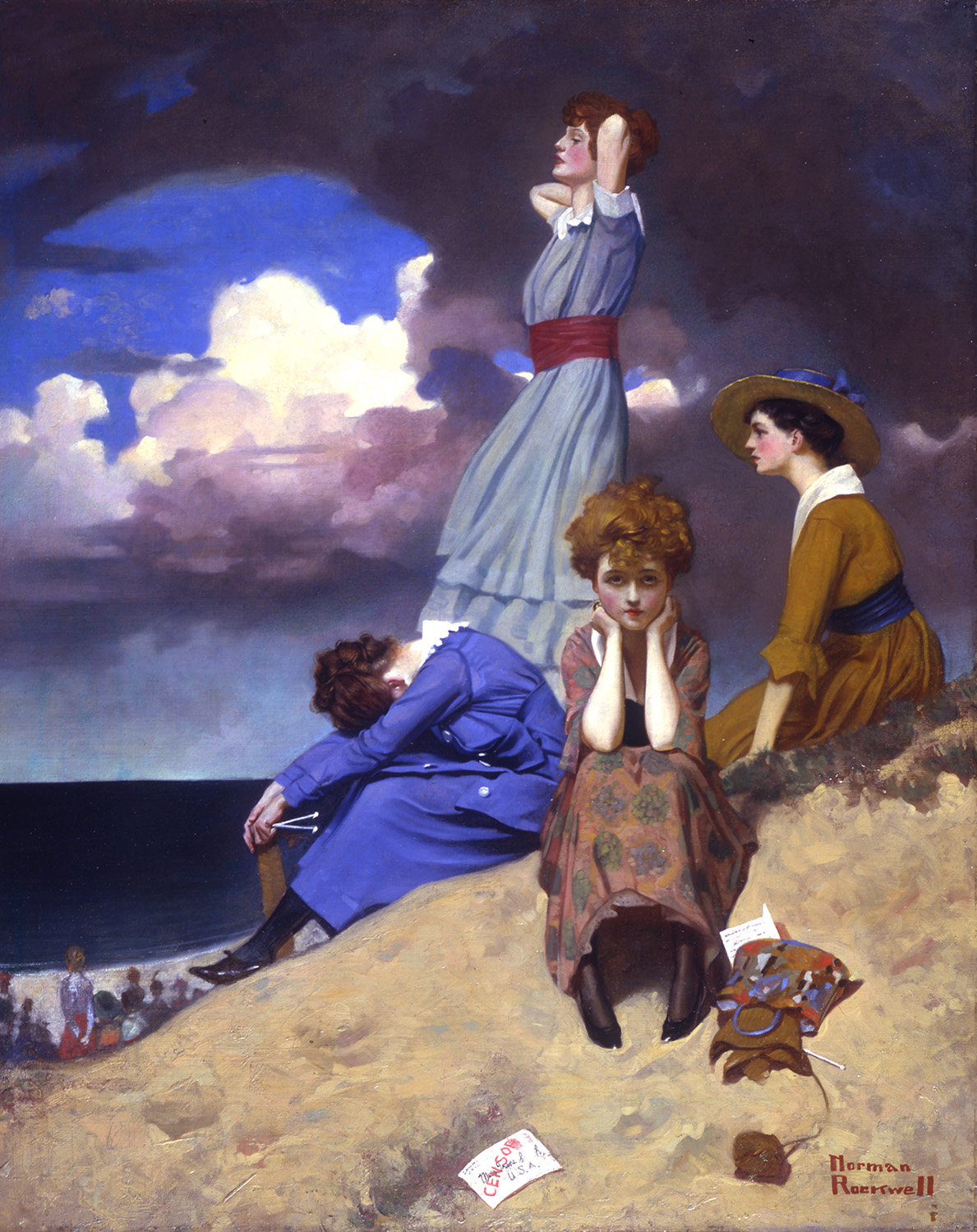
Norman Rockwell (1894-1978)
Till the Boys Come Home
1918, oil on canvas
29 1/2” x 23 1/2”, signed lower right
Life Magazine, August 15, 1918 cover
Throughout the 19th and most of the 20th centuries the Postal Service was the primary means of communication. Because of the limited alternatives, its continued service was a crucially important factor in people’s lives to allow for friends and loved ones to remain connected, particularly in times of hardship. Norman Rockwell painted this heartbreaking scene during World War I depicting young women waiting for news from their beloved young men fighting in Europe. Even when the hopeful letters arrived, many were edited or redacted for the protection of national secrets, as is indicated by the envelope marked “CENSOR” at the young woman’s feet. This touching Life Magazine cover reflected feelings of longing and frustration that many experienced at home.
Alex Ross (1908-1990)
Getting the Mail
1943, gouache and tempera on board
15" x 11 1/2", signed lower right
Saturday Evening Post, January 29, 1944 cover
Printed 25 years after Rockwell’s Till the Boys Come Home, this Saturday Evening Post cover by Alex Ross reflects similar sentiments felt during World War II. Arriving home from a Winter sleigh ride, this young woman checks the mailbox hoping for news from a loved one abroad. While the artwork does not explicitly indicate what she is thinking, every American viewing this cover in January 1944 would immediately understand Ross’ implications and relate to her hopeful wishes for what the mailbox may contain.

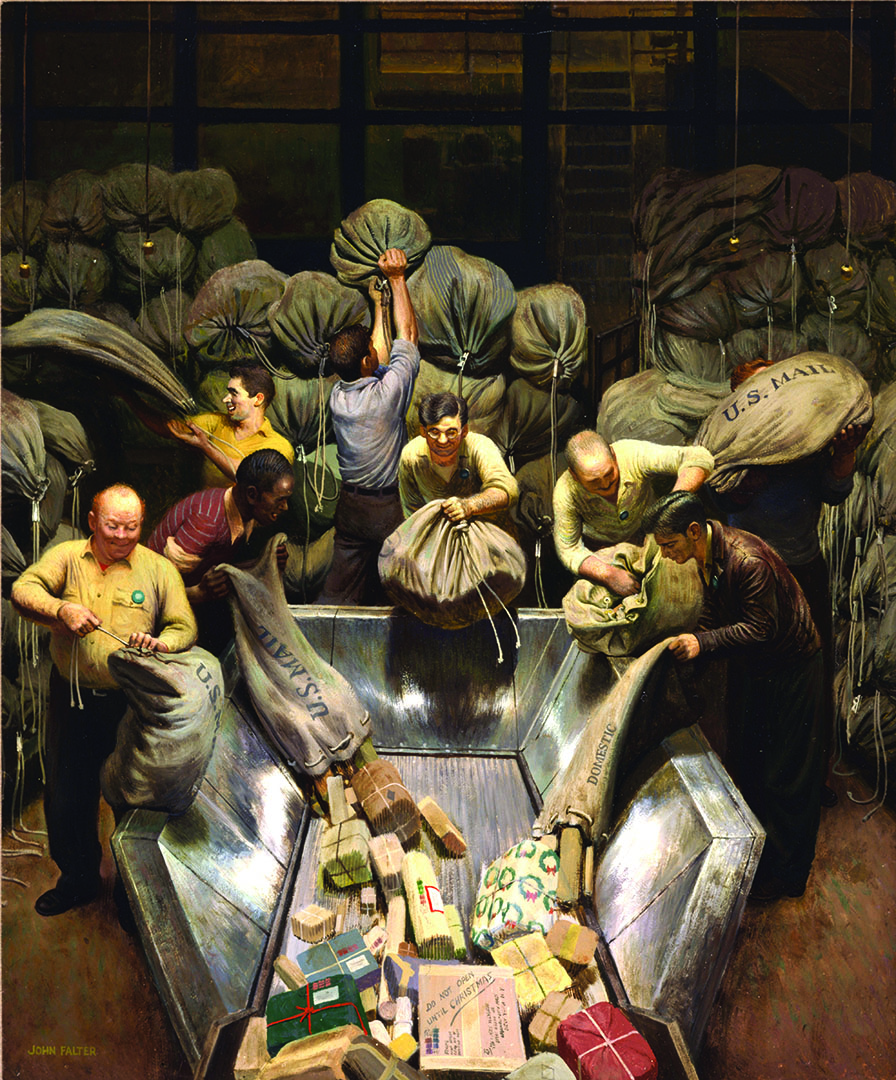
John Falter (1910-1982)
Christmas Mail Rush
1945, oil on board
24” x 20”, signed lower left
Saturday Evening Post, December 8, 1945 cover
When loved ones cannot join together for popular holidays, the Postal Service never fails to spread messages of happiness across the United States and abroad. John Falter captures the hustle and bustle of the Christmas season at a local postal center with this image. At the height of their most popular time of year, the postal employees empty sacks filled with packages of brown-paper and brightly colored wrappings into a sorting bin to be distributed to their final destinations. Each man appears joyful to be helping in the process of bringing people together during the Holiday season, acting as a real-life Santa Claus to many.
Stevan Dohanos (1907-1994)
Don't Delay - Mail Today (Post Office in Georgetown)
1947, oil on canvas
28" x 22", signed lower left
Saturday Evening Post, December 13, 1947 cover
Stevan Dohanos had a close relationship with the United States Postal Service. He served as the chairman of the Citizens’ Stamp Advisory Committee, which selected the stamp's artworks, as well as designing 46 stamps of his own. For this Saturday Evening Post Christmas cover, Dohanos depicted a local farmer bringing his decoratively wrapped gifts, carefully balanced in his arms, to his local Georgetown Post Office. Printed on December 13th, the viewer can see that these gifts should arrive to their intended recipient on time; as the sign reminds patrons, “Don’t Delay Mail Today”!


Mead Schaeffer (1898-1980)
San Francisco Cable Car
1945, oil and pencil on canvas
32” x 26”, signed lower right
Saturday Evening Post, September 29, 1945 cover
In major cities and towns across the country, many residents rely solely on public transportation to go to work, complete necessary chores, and connect with others. Without the dedicated individuals who keep these public services functioning properly, the city and its residents can suffer debilitating consequences. Printed just weeks after the end of World War II, Mead Schaeffer illustrated this joyful scene of sailors running after a San Francisco trolley with their belongings in tow, excitedly headed towards the beginning of their journey home.
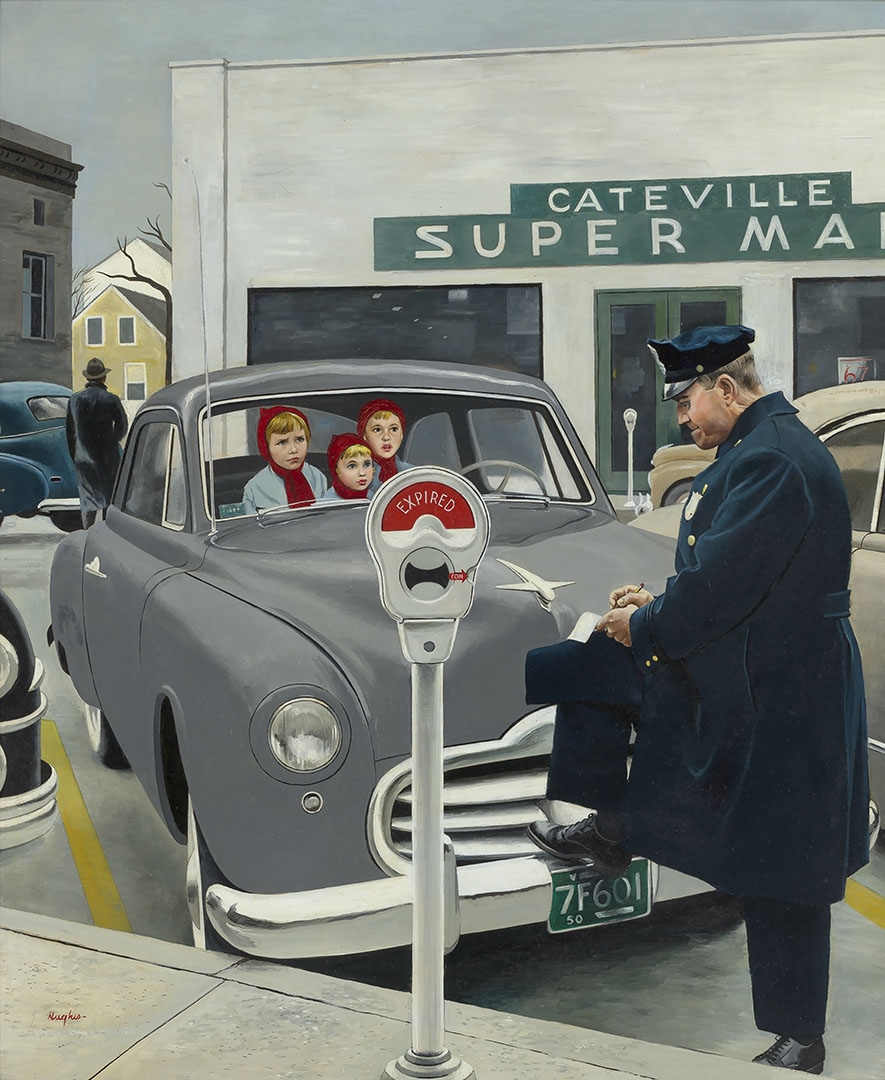
George Hughes (1907-1990)
Expired Meter
1950, oil on board
24” x 19 5/8”, signed lower left
Saturday Evening Post, February 10, 1951 cover
George Hughes’ work for the Saturday Evening Post was immediately recognizable and very popular due to his ability to capture typical America with humorous family situations in brilliant colors and accurate settings as can be seen in this 1951 cover, Expired Meter. A mother has left her three daughters in the car, all stylishly dressed in matching coats, red hats and scarves, as she dashes into the supermarket. As the children patiently wait, a policeman notices the expired meter and writes them a ticket, dutifully completing his job. The distress on the children’s faces over this perplexing situation is palpable, surely wishing their mom meant it when she said she would “be back in just one minute”.
Stevan Dohanos (1907-1994)
Ice Cream Break
1951, oil on masonite
37” x 29 1/2”, signed lower left
Saturday Evening Post, September 22, 1951 cover
Born in the steel mill town of Lorain, Ohio, Stevan Dohanos spent most of his career in Westport, Connecticut and was considered an 'American Realist.' A proponent of simplicity, he has said, "A clean, strong, uncluttered image forms the basis of a good picture," and his illustrations "always gloried in finding beauty in the ordinary things of life.” This 1951 Saturday Evening Post cover illustration does just that. A highway patrol officer takes a break on a hot September afternoon at an ice cream rest stop watching the cars breeze by him over two scoops of vanilla. The scene’s simplicity makes it relatable to many different audiences across the country, something that may be viewed looking out one’s own car window.
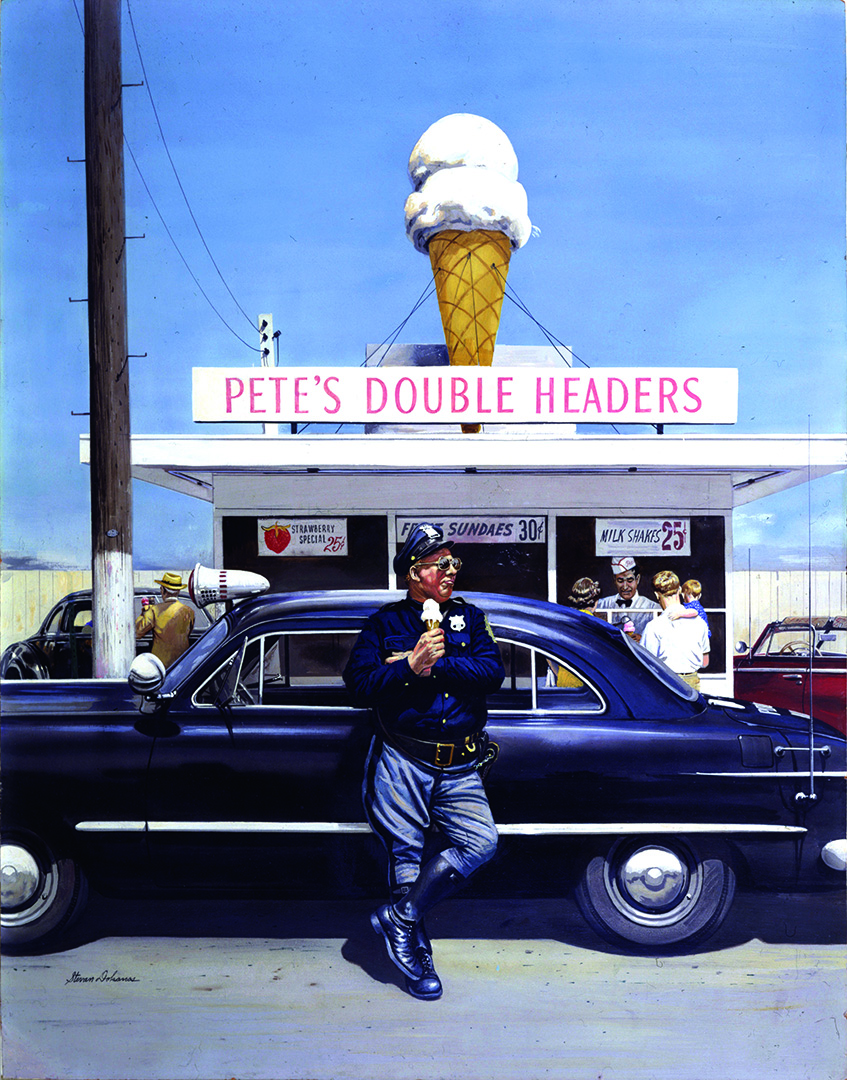
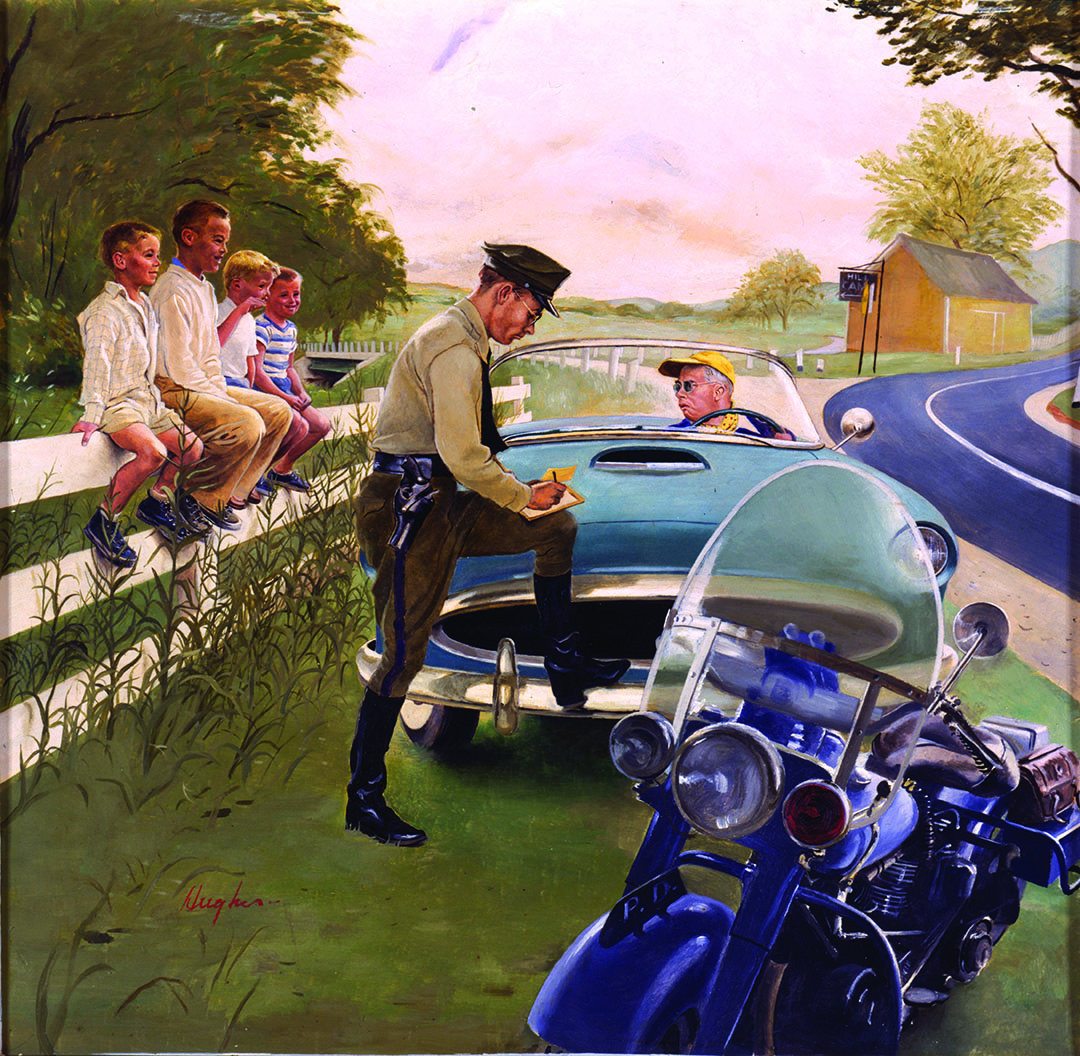
George Hughes (1907-1990)
Just Doing His Job
1957, oil on board
20 1/2” x 20 1/2”, signed lower left
Saturday Evening Post, April 27, 1957 cover
This is George Hughes’ second Saturday Evening Post cover of an officer issuing a ticket in this exhibition (maybe the artist himself received quite a few in his day?). In this 1957 illustration the driver is in the hot-seat being issued a ticket while the children, perched on the fence, watch on in amusement. The four young boys can not believe their luck that such an event would happen in their own yard and have claimed front row seats to watch the officer in action. The driver seems less than amused at their snickering, while the officer ignores them and goes about his job in a serious manner.
Stevan Dohanos (1907-1994)
Muddied by Dry Cleaning Truck
1948, oil on canvas
28" x 22", signed lower left
Saturday Evening Post, October 22, 1948 cover
Finding the irony in everyday situations to highlight their humor was Stevan Dohanos’ specialty. In this 1948 Autumnal cover for the Saturday Evening Post, he depicted three generations of women beautifully dressed in their rainy-day attire waiting patiently at their neighborhood bus stop. They remained clean and dry under their umbrellas until a dry cleaning truck speeds by, splashing them with the street runoff. Not only are they surely soaked now, but the thought of bringing these clothes to that very same cleaner the next day is almost laughable.

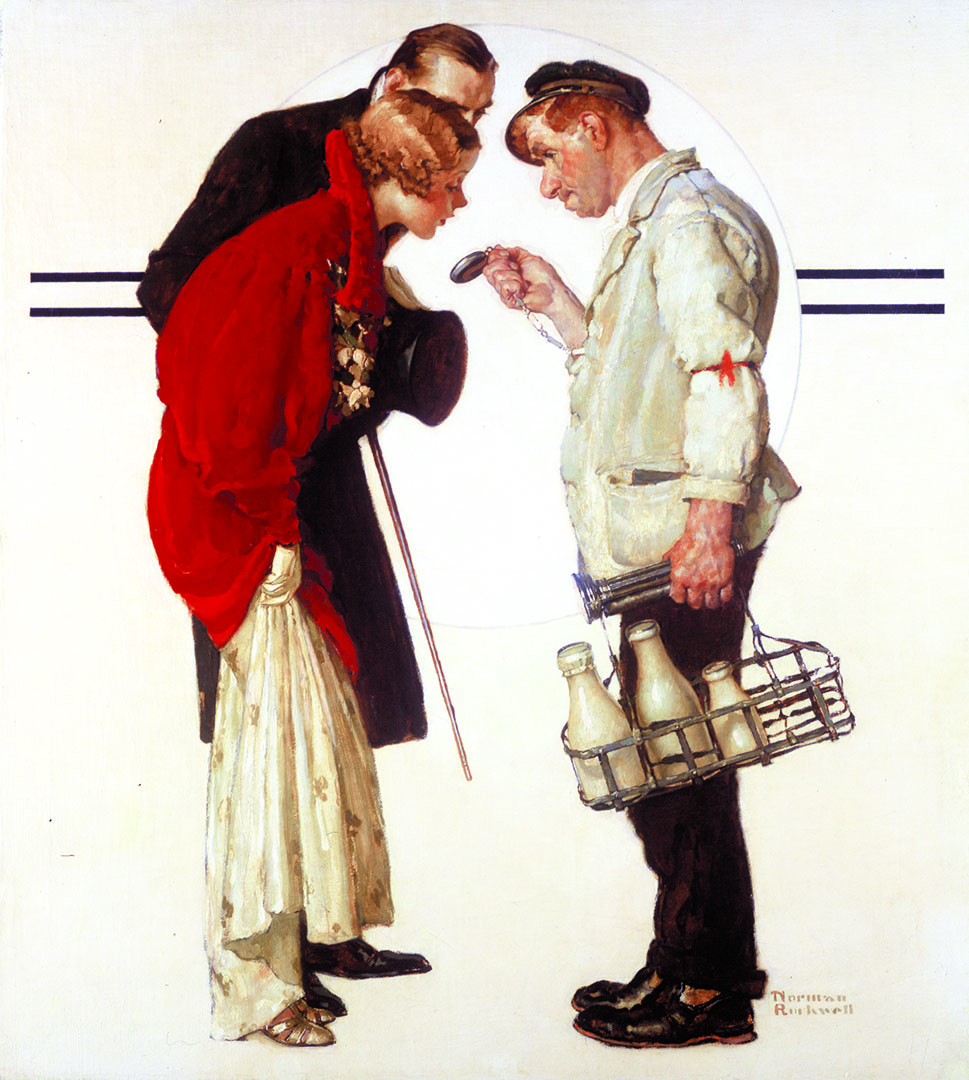
Norman Rockwell (1894-1978)
Couple with Milkman
1935, oil on canvas
30” x 27”, signed lower right
Saturday Evening Post, March 9, 1935 cover
"[This] 1935 cover brings us right back in the twentieth century. A pair of partygoers returning home has stopped to consult a milkman's watch. The couple appears to be a little surprised to discover how late it is, but they are hardly overcome by shock. This is, after all, the thirties. Not the thirties of the Depression, but the thirties which produced the compensating myth of Hollywood and the Great White Way. This is the thirties of Katherine Hepburn, Cary Grant, Clark Gable, and Jean Harlow; of The Philadelphia Story and Flying Down to Rio; of Cole Porter, Rodgers and Hart, Irving Berlin, and Noel Coward. Any self-respecting pair of partygoers returning home would stop a milkman to ask the time; it would be the final seal of approval on a successful date."
(Norman Rockwell's America, by Christopher Finch, New York, 1975, p. 86)
Stevan Dohanos (1907-1994)
Supermarket
Saturday Evening Post, November 13, 1948 cover
For his November 13, 1948 Saturday Evening Post cover, Dohanos highlighted the humble American grocery store. Where most go to purchase their foods and goods, it was the place for many different people to interact. In the image, the grocer and assistant struggle to fit the first woman’s purchases into the bags, while the baby of the next woman attempts to grab at each item. A young boy maneuvers his way under a railing to climb on top of a box for a better view of the commotion, while his mother waits patiently for their turn. Unfortunately, at the back of this lengthy line, a gentleman waits with a single bottle of milk, cash in hand ready to pay, looking less than pleased about these delays to his quick errand.
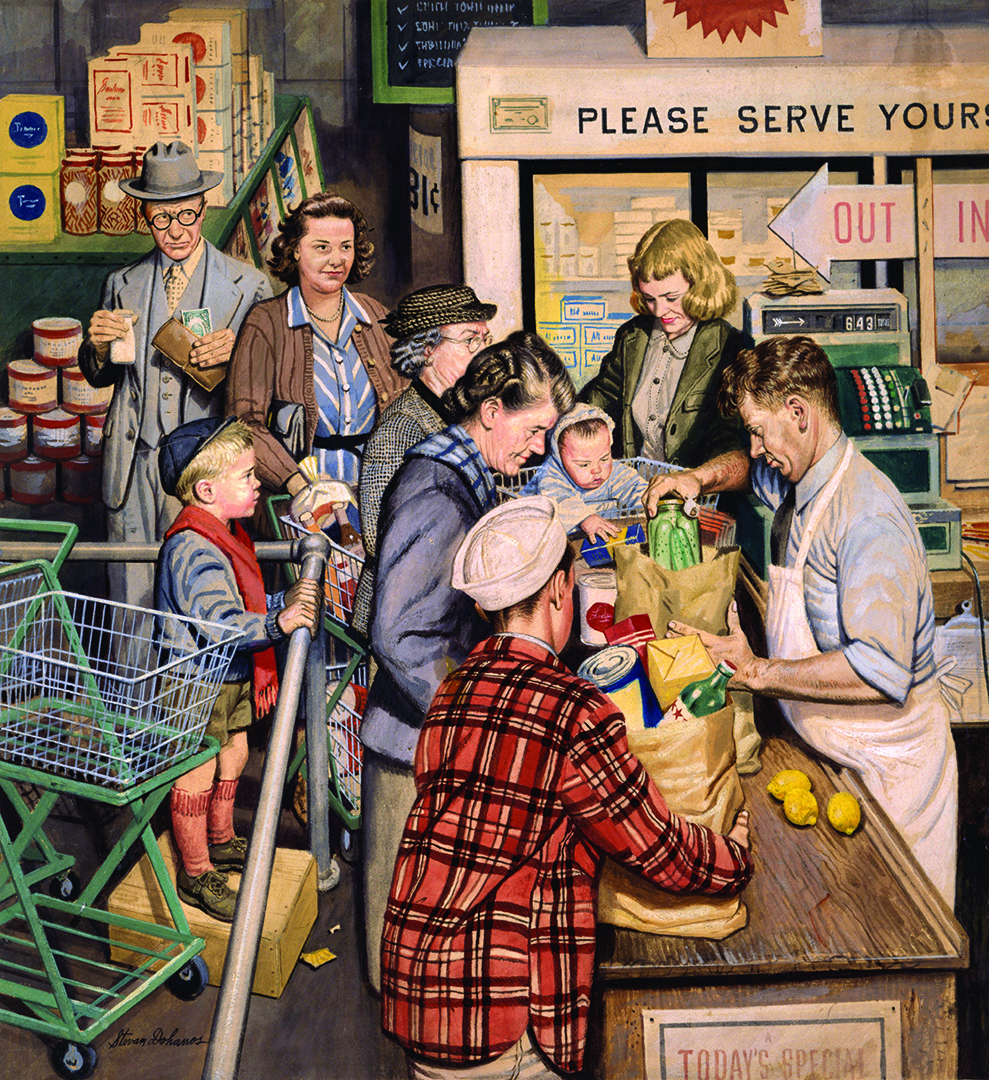
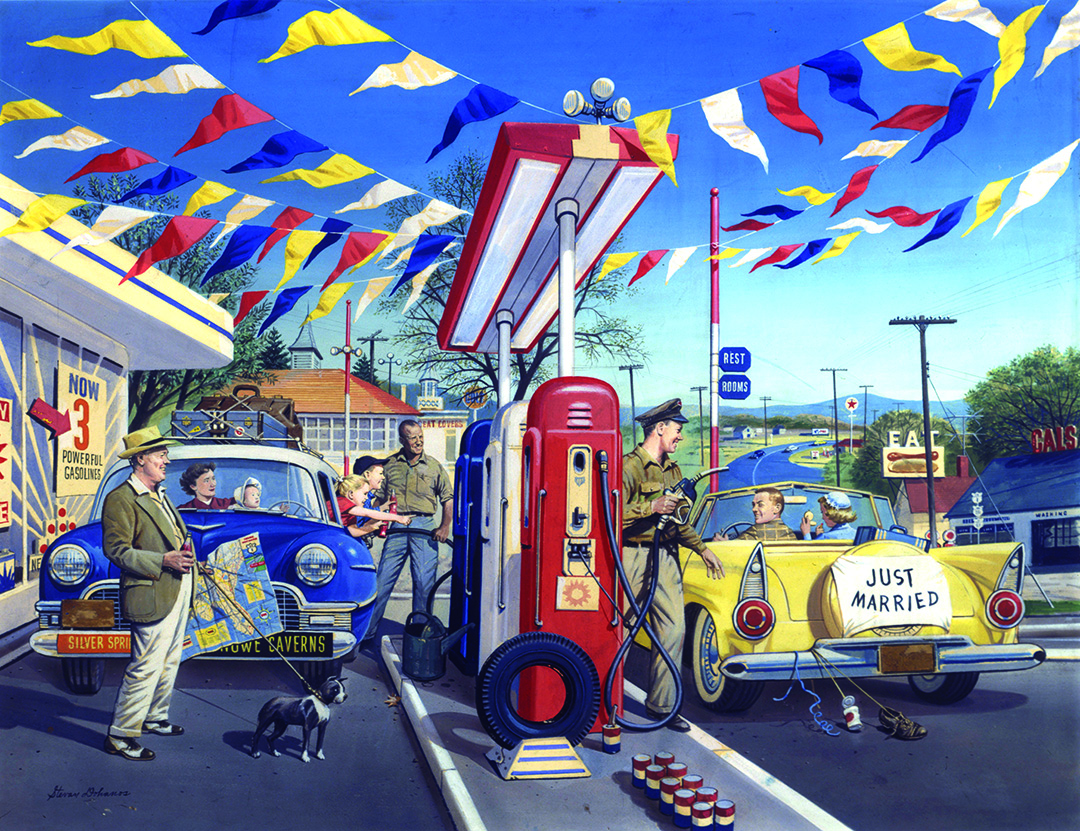
Stevan Dohanos (1907-1994)
Fill Her Up
Oil on canvas
27 1/2” x 21 1/2”, signed lower left
Advertisement for Oxford Paper Company
Stevan Dohanos cleverly designed this advertisement for the Oxford Paper Company by integrating different uses of paper into many aspects of this typical gas station scene. The yellow car on the right is adorned with a “Just Married” sign, perfectly created from a sheet of paper and adhered to the spare tire. The gentleman on the left holds a crisp paper map in his hand as he watches them prepare to leave. The signs in the station window and vibrant flags overtop also highlight the paper’s long-lasting quality and varied uses in this scene.
